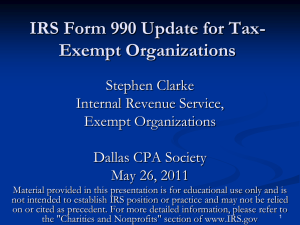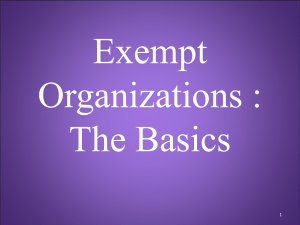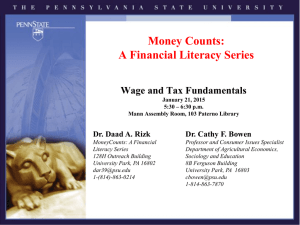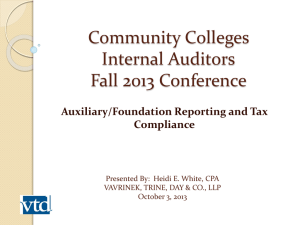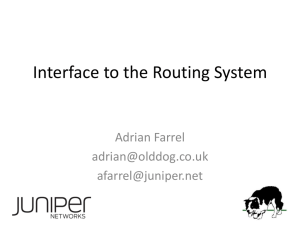Mitigating Audit Risks and Maximizing Opportunities with
advertisement
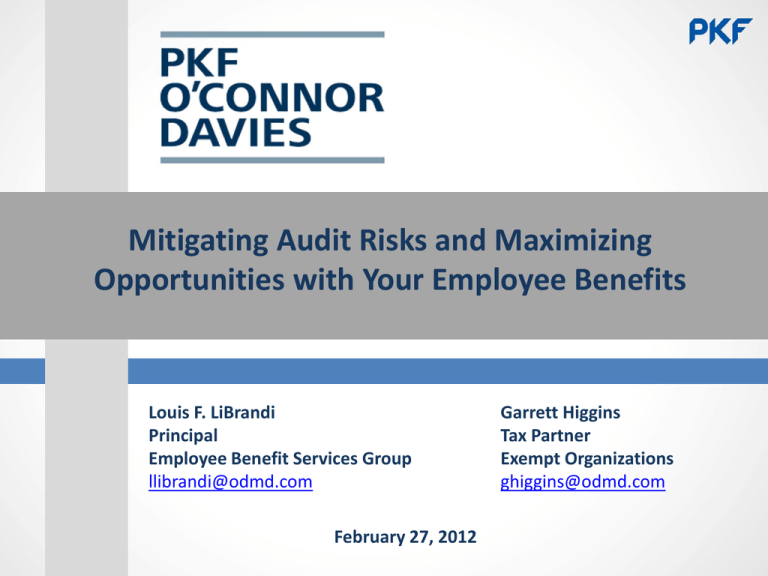
Mitigating Audit Risks and Maximizing Opportunities with Your Employee Benefits Louis F. LiBrandi Principal Employee Benefit Services Group llibrandi@odmd.com February 27, 2012 Garrett Higgins Tax Partner Exempt Organizations ghiggins@odmd.com Agenda I. History of Employee Benefit Plans, Revision of Form 990 and Additional Background Information II. Increased Scrutiny of Compliance and Reporting By the IRS, DOL, the Attorney General and other regulatory / watchdog agencies III. Reporting Requirements • • Employees Plans – Form 5500 Exempt Organizations – Form 990 CMAA - World Conference 2/27/12 2 Agenda (continued) IV. IRS Compliance Checks • • Employee Plans Exempt Organizations V. Examination and Investigation Issues • • • 401(k) Plans Cafeteria Plans 501(c)(7) Social Clubs VI. Self Audit and Correction CMAA - World Conference 2/27/12 3 History of Employee Benefit Plans, Revision of Form 990 and Additional Background Information I. History and Background How did pension plans and employee benefit plans start • 1800’s – The earliest pension plans started in the late 1800’s – (AMEX 1875) in the railroads, banking, and utilities industries • 1920’s – Insurance administer plans • 1940’s – Wage stabilization and price controls. Unions began to negotiate fringe and pension benefits for employees • 1950’s and 1960’s – Unions were using the plans assets for purposes other than the intended purposes • 1963 Studebaker pension plan failure raises government and workers attention • Culminated in the passage of the Employee Retirement Income Security Act of 1974 (“ERISA”) CMAA - World Conference 2/27/12 companies 5 and group products began to I. History and Background (continued) Revised Form 990 – Overview • On June 14, 2007, the IRS released redesigned Form 990 • First major revision to Form 990 since 1979 – Old form failed to keep pace with changes in tax law – Failed to meet IRS compliance interests – Failed to meet needs of the states • On December 19, 2007, the IRS released its final version • Organizations began using this form for the 2008 tax year (returns filed in 2009) • Instructions significantly revised CMAA - World Conference 2/27/12 6 I. History & Background (continued) IRS’ Guiding Principles for Revision • Enhancing Transparency • Promoting Tax Compliance • Minimizing Burden of the Reporting Organization CMAA - World Conference 2/27/12 7 Important Statistics • There is close to $5 trillion dollars in pension plan assets. • There are over 708,000 retirement plans and 2.8 million health plans and a similar number of other Welfare Plans (life, disability, etc.) covering over 150 million workers and their dependents. All of these employee benefit programs are regulated under the watchful eye of the Federal Government. • IRS Agents: • • – EP – 400 – EO – 900 IRS Completed Examinations: – EP – 10,000 – EO – 12,000 DOL - EBSA recovered over $1 billion dollars in FY 2010 resulting from their investigations. CMAA - World Conference 2/27/12 8 Increased Scrutiny of Compliance and Reporting By the IRS, DOL, the Attorney General and other regulatory / watchdog agencies II. Increased Scrutiny of Compliance and Reporting By the IRS, DOL, the Attorney General • • • • Additional hiring of examiners including; accountants, attorneys, and former “C” level employees by the governmental agencies Sophistication of workers and computer processing of filed information with the government Increased sophisticated training concepts and tools being provided to government employees Mutual cooperation/coordination between the governmental agencies at all levels (State, Federal agencies) CMAA - World Conference 2/27/12 10 II. Increased Scrutiny of Compliance and Reporting By the IRS, DOL, and the Attorney General (continued) • The Governmental Agencies receive forms and information from various employer filings (e.g. W-2, 941, 1099, 5500, 990, 990-T, etc.) • During an examination the agents and investigators review other documentation – plan documents including summary plan descriptions, – notices and communication to employees, employee handbooks – committee meeting minutes, – written policies and procedures used in processing operations involving financial or tax reporting – governing documents and other industry specific information CMAA - World Conference 2/27/12 11 II. Increased Scrutiny of Compliance and Reporting By the IRS, DOL, and the Attorney General (continued) 1. Employee Plans Compliance Unit (EPCU) - Pension/Retirement Plans 2. Exempt Organizations Compliance Unit (EOCU) - Review of Operations (ROO) - Data Analysis Unit (DAU) CMAA - World Conference 2/27/12 12 Reporting Requirements III. Form 5500 Reporting Requirements • Form 5500 - Annual Return/Report of employee benefit plan (generally pension & welfare) • Used to satisfy the annual reporting requirements for the DOL, IRS & PBGC • Primary source of information reported to the government about employee benefit plans • Used for enforcement, research & disclosure CMAA - World Conference 2/27/12 14 III.Form 5500 Reporting Requirements (continued) List of Employee Benefit Plans Retirement Welfare Fringe Benefits 401(k) Premium-Only-Plan 403(b) Health Insurance • Vision • Dental Profit Sharing Life Insurance Qualified Transportation Defined Benefit Educational Assistance Money Purchase Disability Plans – Long Term – Short Term Employee Stock Ownership Plans Cafeteria Plan w/Health FSA Fitness Memberships Accidental Death & Dismemberment Awards Dependent Care Assistance Plans Outplacement Services Severance Plans CMAA - World Conference 2/27/12 15 III.Form 5500 Reporting Requirements (continued) • Who Must File? Retirement Plans - 1 man plans/sole proprietorships/partnerships – Form 5500-EZ - Small Plans (less than 100 participants) – Form 5500-SF - Large Plans (100 or more participants) – Form 5500 Welfare Plans - Large Plans only (100 or more participants) • When is Form 5500 Due to be Filed? - 7 months after plan year ends - Timely filed Extension Form 5558 +2.5 months CMAA - World Conference 2/27/12 16 III.Form 5500 Reporting Requirements (continued) • Exceptions to the Form 5500 Filing Requirements - Small Welfare Plan (less than 100 participants) - Fringe Benefit Plans – See listing of Fringe Benefits Plans. IRS Notice 2002-24 - Church Plans or other Non-ERISA Plans (403(b) plan) - Nonqualified Deferred Compensation Plans. - If the NQDC plan filed a registration statement with the DOL Solution: Review all types of employee benefit plans/programs and determine if all the appropriate Form 5500s are filed CMAA - World Conference 2/27/12 17 Part III. Form 990 Reporting Requirements (continued) • Information return submitted to the IRS • Provides comprehensive information about the organization • Public document • Can be used to satisfy state filing requirements • Marketing tool CMAA - World Conference 2/27/12 18 Part III. Form 990 Reporting Requirements (continued) Basic Filing Requirements Who must file: • Most organizations exempt from income tax under IRC – §501(a) must file 990 or 990-EZ or 990-N (electronic postcard) When: • Due 15th day of 5th month after the organizations accounting period ends Exceptions: • Churches and affiliates • Disregarded Entities – Single Member LLC’s - Reg. § 301.7701-1 to 3 • Certain government organizations • Certain political organizations CMAA - World Conference 2/27/12 19 Part III. Form 990 Reporting Requirements (continued) Thresholds for Filing Who must file Form 990? • 2011 – Organizations with gross receipts of $200,000 or more or total assets $500,000 or more at the end of the tax year • Gross Receipts – total amount of received from all sources during the year • Total Assets – amount reported on balance sheet at the end of the year Exceptions to thresholds: • Sponsoring organizations of donor advised funds • Controlling organizations described in § 512 (b)(13) • Supporting Organizations described in §509(a)(3) CMAA - World Conference 2/27/12 20 Part III. Form 990 Reporting Requirements (continued) Thresholds for Filing May file 990 E-Z for: If gross receipts are: And if assets are: 2007 Form (generally filed in 2008) > $ 25,000 and < $ 100,000 < $ 250,000 2008 Form (generally filed in 2009) > $ 25,000 and < $1,000,000 < $2,500,000 2009 Form (generally filed in 2010) > $ 25,000 and < $ 500,000 < $1,250,000 2010 and later Forms > $ 50,000 and < $ 200,000 < $ 500,000 CMAA - World Conference 2/27/12 21 Part III. Form 990 Reporting Requirements (continued) • Mandatory if the organizations has $10 million or more in total assets at the end of the tax year and files at least 250 “returns” during the year • Optional for all other organizations • Definition of “Returns” – includes W-2’s, 1099’s, 941 etc. • If an organization is required to file electronically but does not the organization is considered not to have filed. Even if a paper return is submitted. Temp Reg. §310.6033-4T & Reg. §301.6033-4. • Waiver – Notice 2005-88, 2005-48 I.R.B. 1060 • www.irs.gov/efile CMAA - World Conference 2/27/12 22 Part III. Form 990 Reporting Requirements (continued) Failure to File Penalties • §6652(c)(1)(A) – Penalties for failure to file – Begin on due date of return • Reasonable cause • $20 per day not to exceed smaller of: – $10,000 or • 5% of gross receipts for the year • Large Organizations (annual gross receipts > $1 million) – $100 per day • Maximum of $50,000 per return CMAA - World Conference 2/27/12 23 Part III. Form 990 Reporting Requirements (continued) Failure to File Penalties (Continued) What constitutes organizations failure to file? • Not filing / Late filing • Filing incomplete tax return • Return contains incorrect information Penalties charged against responsible persons: • Organization must respond to IRS notice of failure to file • §6652(c)(1)(B)(ii) - Individual charged penalty of $10 per day with maximum of $5,000 Penalties for willfully not filing or filing fraudulent returns: • Penalties at the state level CMAA - World Conference 2/27/12 24 Part III. Form 990 Reporting Requirements (continued) Public Disclosure Requirements • §6104 IRC – Information open for public inspection • Exact copy of annual returns, applications for exemption, and other information required to be furnished under §6033, §6034, §6058 • 3-year limitation on inspection of returns - Information available in person or on internet - Reasonable Fee Charge (postage, copy charge permitted) - Penalties for non-compliance - Amended returns begin new 3 year period • Exceptions from disclosure: - Schedule B – Schedule of contributors - Organizations not considered private foundations CMAA - World Conference 2/27/12 25 IRS Compliance Checks and initiatives in support of its continued compliance efforts IV. IRS Compliance Checks • What is a Compliance Check? A compliance check is not an examination and a taxpayer may choose not to participate. There is no penalty for not participating. It is a tool that is used to contact a taxpayer that involves a review of filed information and tax returns of the entity. • Compliance Checks Do’s and Don'ts Do's Don’ts • Discuss internal controls • Inspect books and records • Evaluate procedures • Discuss books and records • Inspect filed reports • Question employee classification (IC or EE) • Accept and process amended or delinquent Form filings CMAA - World Conference 2/27/12 27 IV. IRS Compliance Checks (continued) • How are taxpayers contacted for compliance checks ─ — — — — — Contact is made in writing by the providing of a letter to the plan sponsor. Telephone calls is another method. The IRS does not use email to initiate contact. Taxpayers can use a representative to respond to a compliance check. A Form 2848 Power-of-Attorney (POA) must accompany the response to the IRS when a representative is used. The IRS can send a copy of the compliance check closing letter to the POA. CMAA - World Conference 2/27/12 28 IV. IRS Compliance Checks (continued) • What are the differences between a compliance check and an examination of a return? There are several key differences. ─ A compliance check is not an audit or an investigation under Code §7605(b). ─ A compliance check does not preclude a plan sponsor’s use of IRS correction programs to correct plan errors. ─ Upon receipt of a written or oral Notice of Audit, the plan sponsor is prohibited from filing a Voluntary Correction Program application under the IRS’s Employee Plans Compliance Resolution System (“EPCRS”). • What could happen if there is no response to a compliance check questionnaire? ─ Failure to answer the correspondence could result in further action, including examination of the plan. CMAA - World Conference 2/27/12 29 IV. IRS Compliance Checks (continued) Employee Plans Compliance Check Current Projects Form 5330 - 4979 Excise Tax Multiemployer Certification Compliance Project (Follow-up to those not submitting annual certifications) Form 5500 Non-filer Funding Deficiencies Nonbank Trustees and Custodians Hacienda Project Partial Termination/Partial Vesting International Project - Domestic Trusts Plan Participation Project - New International Project - Foreign Distributions Qualifying Employer Securities Project Invalid 501(c)(18) Deferrals Project Simplified Employee Pension Plans (SEPs) Project Leased Employee Project Termination Project - New Multiemployer Actuarial Certification/WRERA Elections Project (Annual Certification Requirement) 401(k) plan with money purchase plan assets CMAA - World Conference 2/27/12 30 IV. IRS Compliance Checks (continued) Form 5500 Non-Filer Project • IRS and DOL are contacting plan sponsors who did not file a Form 5500 with the DOL (or 5500-EZ with the IRS) for the plan years ended in 2009 or later • Penalty structure for late filings: - IRS $25 a day up to $15,000 - DOL (civil) $1,100 a day with no maximum Solution: Consider preparing Form 5500 and filing under the DOL reduced penalty filing program – Delinquent Filer Voluntary Compliance (“DFVC”). There is a significantly reduced penalty structure to correct non-filed Forms. (For example, $10 a day, or $1,500 small plan, $2,000 large plan) CMAA - World Conference 2/27/12 31 IV. IRS Compliance Checks (continued) Partial Plan Termination • Occurs because of plant/facility shutdown, layoffs, downsizing, sale of a group of employees/division • Significant reduction of 15% - 20% of participants • Frequently IRS reviews more than 1 year for determination • Is employer following requirements if a partial termination occurred? • Affected participants must be 100% vested in their benefits Solutions: – Review of reasons for the reduction of participants – Any employer actions; RIF or layoff, consider retirement plan impact – Attach PDF to Form 5500 indicating issue reviewed, participants 100% vested CMAA - World Conference 2/27/12 32 IV. IRS Compliance Checks (continued) Termination Project • Final filings of Form 5500 must 1. Report $0 assets 2. No participants 3. If transferred assets – report on Schedule I or H 4. If plan merged into another plan - report on Schedule H Solution: Prepare and file amended final Form 5500 as a response to inquiry CMAA - World Conference 2/27/12 33 IV. IRS Compliance Checks (continued) IRS Areas of Focus • Utilization of Form 990 • Unrelated Business Income • Corporate Governance • Executive Compensation • Industry Specific CMAA - World Conference 2/27/12 34 IV. IRS Compliance Checks (continued) Utilization of Form 990 • • • • “Self-Audit” Discloses critical information Identify industry specific non-compliance areas Develop questionnaires • College and University • Healthcare • Others to come • Create compliance checklists CMAA - World Conference 2/27/12 35 IV. IRS Compliance Checks (continued) Utilization of Form 990 How does an organization mitigate exposure? • Submit a complete and accurate Form 990 • Create internal review procedures • Conduct period internal audits of the information • Establish a board review process CMAA - World Conference 2/27/12 36 IV. IRS Compliance Checks (continued) Unrelated Business Income • Form 990 – Part I – Gross Unrelated Business Income – Part I – Net Unrelated Business Income • Applying lesson learned from previous questionnaires and compliance checks – College & University Questionnaire – 2012 IRS Workplan • Tax revenue from unrelated sources CMAA - World Conference 2/27/12 37 IV. IRS Compliance Checks (continued) Unrelated Business Income How does an organization mitigate exposure ? • Create policy and procedures • Track and document income • Track and document expenses and expense allocation • Capture losses by filing CMAA - World Conference 2/27/12 38 IV. IRS Compliance Checks (continued) Corporate Governance Why Is Good Governance Important? • Risk management • Keeps focus on the mission • Good governance prevents pitfalls (conflicts of interest, private benefit transactions and loss of exemption) • Good governance = tax compliance • IRS trained agents to review governance • Governance Checksheet Roll out in 2011 CMAA - World Conference 2/27/12 39 IV. IRS Compliance Checks (continued) Corporate Governance How does an organization mitigate exposure ? • Adopt necessary policies • Annually monitor, enforce and update policies • Completely respond to governance questions • Make sure narratives are accurate on Form 990 CMAA - World Conference 2/27/12 40 IV. IRS Compliance Checks (continued) Executive Compensation Can not exceed FMV of services rendered • Form 990, Part VII, Schedules J and O • Private Benefit • Private Inurement • Detailed Compliance checks CMAA - World Conference 2/27/12 41 IV. IRS Compliance Checks (continued) Executive Compensation How does an organization mitigate exposure? • Adopt compensation policy and procedures • Create or designate a compensation committee • Establish a rebuttable presumption of reasonableness – Independent board members – Relying on comparable data – Properly documenting minutes • Properly report all compensation of Form 990 CMAA - World Conference 2/27/12 42 IV. IRS Compliance Checks (continued) Industry Specific Focus • 501(c)(7) – Social Clubs • 15% / 35% Rule • Non-Member Documentation • Revocation of exempt status • Investment income project • Unrelated business income (UBI) • UBI Expense allocation • Employee Classification (IC vs. ER) • Gaming non-filer project CMAA - World Conference 2/27/12 43 Examination and Investigation Issues V. Examination and Investigation Issues • The IRS and DOL have issued their Priority Guidance and Workplans for 2011-2012 • Both agencies workplans indicate an increase in the number of examinations/investigations of retirement plans • The IRS has increased the number of 401(k) plans it will examine • DOL has stated over 77% of 401(k) plans are noncompliant in some manner • In 2010, over 1000 investigations were initiated by complaints to the DOL • Federal deficit may be impacting the agencies need to collect all penalties and interest CMAA - World Conference 2/27/12 45 V. Examination and Investigation Issues (continued) • Accommodation and Food Services (401(k) plans) The following issues were identified based on the results of at least 500 examinations. These results were updated in July 2011. - ADP/ACP Testing - Timely remittance of employee contributions - Contribution allocation errors 1. Not following plan terms 2. Using incorrect definition of compensation 3. What about forfeitures - Failure to amend plan document CMAA - World Conference 2/27/12 46 V. Examination and Investigation Issues (continued) • ADP/ACP Testing (Pre-Tax Deferrals and ER Matching Contributions) Issue: Noncompliance of these tests can result in tax sanctions($), additional employer contribution with earnings, and penalties Problems: 1. Tests not completed or not corrected 2. Determining the highly compensated ($110,000 – 2010) and nonhighly compensated employees 3. Using correct definition of compensation 4. Form 5330 not timely filed to pay 10% excise tax when ADP fails Solution: Depending on severity of issue; IRS-voluntary application (fee) or self-correction CMAA - World Conference 2/27/12 47 V. Examination and Investigation Issues (continued) • Timely Remittance of Employee Contributions Issue: The DOL expects employee contributions to be transmitted to the plan within seven business days if a small plan, or more frequent if a large plan Problems: 1. Failure to timely transmit results in disclosure on Form 5500 and/or accountant’s report 2. Increase likelihood of DOL/IRS scrutiny 3. Correction involves additional contribution by employer of lost earnings 4. Filing of tax Form 5330 with excise tax payment to IRS Solution: DOL voluntary VFC* application is recommended *VFC = Voluntary Fiduciary Correction CMAA - World Conference 2/27/12 48 V. Examination and Investigation Issues (continued) • Forfeitures Issue: Plan documents provide proper use or disposal of amount Problems: Not following plan terms; 1. Reduce future employer contributions 2. Pay plan administrator expenses 3. Allocate to remaining participant accounts 4. Timing of when to use forfeiture Solution: Usually can be self-corrected following IRS principles CMAA - World Conference 2/27/12 49 V. Examination and Investigation Issues (continued) • Failure to Amend Plan Issue: Plan document has not been updated for recent law changes (Ex. - PPA 2006, HEROES, WRERA) Problems: Qualified retirement plan documents require frequent amendments 1. Plan is required to be amended retroactively 2. May require retroactive operational changes costing employer $$$ 3. Plan document errors can only be fixed by application to IRS Solution: Have the original plan document(s), subsequent amendments, and any related board minutes reviewed by an expert to determine if plan was updated timely CMAA - World Conference 2/27/12 50 V. Examination and Investigation Issues (continued) Cafeteria Plans I. Written plan document requirement - Frequently flexible spending accounts - medical and dependent care are included - Mandatory items include: 1. Eligibility 2. Procedures for enrolling and changing elections 3. Funding; EE + ER contributions and maximum amount 4. Plan year 5. Grace period for incurring expenses (2½ months) CMAA - World Conference 2/27/12 51 V. Examination and Investigation Issues (continued) Cafeteria Plans (continued) II. Compliance/Nondiscrimination Tests (Not Applicable to Premium-Only-Plans) - 25% Concentration Test/ Key EE’s - Flexible Spending Accounts 1. Eligibility 2. Benefits and Contributions 3. Average Benefit Test – 55% (Dependent Care only) The objective of the tests are to ensure the Highly Compensated Employees (HCEs) do not benefit in an unreasonable manner. CMAA - World Conference 2/27/12 52 V. Examination and Investigation Issues (continued) Cafeteria Plans (continued) III. Operational/Issues - Failure to obtain written election by employee - Elections to participate are irrevocable unless status change rule is satisfied (e.g., loss of spouses health plan, add dependent, etc.) - Reimbursement is made for only substantiated medical expenses incurred by employee, spouse or dependent CMAA - World Conference 2/27/12 53 V. Examination and Investigation Issues (continued) Cafeteria Plans (continued) IV. Consequences of Noncompliance - Plan Document or Operational Failures Result in Adverse Federal Tax Consequences • Employee Liability: Inclusion in Participant’s Gross Income Value of Taxable Benefit. (Generally will be limited to HCEs only) • Employer Liability: Tax Withholding/Reporting and FICA Tax Liability Alert: No de minimis violation exception rule and no provision for retroactive correction CMAA - World Conference 2/27/12 54 V. Examination and Investigation Issues (continued) Cafeteria Plans (continued) IV. Consequences of Noncompliance (continued) Solutions: • Plan document review • Coordinate nondiscrimination testing with administrator or employee benefit consultant • Review a sample of plan transactions • Prepare a written manual/guidelines to follow to administer the plan CMAA - World Conference 2/27/12 55 V. Examination and Investigation Issues (continued) 501(c)(7) – Social Clubs Results from recent IRS Exams - IRS routinely re-calculating the 15% and 35% test - Nonmember gross receipts limit consistently being exceeded - Clubs are not maintaining proper non-member documentation and recordkeeping in accordance with Rev. Proc. 71-17 - Clubs not filing form 990-T or 1099’s - IRS increasing terminations of 501(c)(7) status - IRS scrutinizing reciprocal agreements and non-traditional income activities CMAA - World Conference 2/27/12 56 Self Audit and Correction VI. Self Audit and Correction • IRS recommends and annual check-up of the forms, guides and processes utilized to maintain and operate retirement and employee benefit plans. • An independent review of the ADP/ACP and other compliance tests, the definition(s) of compensation and other key terms contained in the plan document, can assist the plan sponsor to understand the plan’s provisions. • This process will help to identify any omissions requiring proactive corrective actions can be provided to reduce future errors. • Assistance may be needed to complete a voluntary application to the IRS or DOL to correct significant errors. CMAA - World Conference 2/27/12 58 VI. Self Audit and Correction (continued) Sample Workplan Step 1: Review plan documentation, and related Forms (5500, W-2, 1099s, 941) Step 2 : Verify operations and internal controls: interviewing key personnel and identify issues and weaknesses Step 3 : Test plan data; systems used to process, samples Step 4 : Internal report of findings to management/decision makers Step 5: Correct plan failures voluntarily (IRS – Employee Plans Compliance Resolution Program (EPCRS), SC/VCP* or DOL Voluntary Fiduciary Correction (VFC) Program applications Step 6: Revise administration and procedures SC = Self-Correction VCP = Voluntary Compliance Program CMAA - World Conference 2/27/12 59 VI. Self Audit and Correction (continued) Steps to be taken to protect against an IRS audit Step 1: Review your organizations governing documents and compare them periodically to your operations Step 2 : Adopt, update, monitor and enforce corporate governance policies and procedures Step 3 : Examine your organizations website and activities Step 4 : Review your documentation and records to substantiate tax positions taken Step 5: Review employment contracts and stay current with employment and benefit plan tax filings Step 6: Create review process to ensure your Form 990 is prepared completely and accurately CMAA - World Conference 2/27/12 60 VI. Self Audit and Correction (continued) Steps to be taken after winning the audit lottery Step 1: Get organized Step 2 : Designate a single “point of contact” Step 3 : Develop a communication strategy Step 4 : Know which agents are working on your audit Step 5: Designate a location for the audit Step 6: Ask questions and establish a timetable Step 7: Relax and take a deep breath CMAA - World Conference 2/27/12 61 Garrett M. Higgins, CPA Partner Tax Practice Group Garrett M. Higgins, CPA is the Partner in charge of the Exempt Organization Tax and Advisory Services Group of O’Connor, Davies, LLP. Mr. Higgins previously worked with KPMG’s Exempt Organizations Tax Practice in New York and has more than seventeen years of tax compliance and consulting experience specializing in tax exempt organizations. His clients include private foundations, colleges and universities, museums, healthcare organizations, large public charities, social clubs, business leagues, pension and welfare benefit trusts, as well as other tax exempt organizations. Mr. Higgins has significant experience advising clients in a broad range of tax compliance and consulting issues including: exemption application assistance, return preparation and review; private foundation excise taxes; unrelated business income tax analysis and planning, state and local tax planning and reporting, strategic use of limited liability companies, taxable subsidiaries and foreign entities, foreign CMAA - World Conference 2/27/12 Phone: 914.381.8900 Fax: 914.381.8910 Email: ghiggins@odmd.com bank account and foreign entity reporting, executive compensation intermediate sanctions planning and compliance and IRS dispute resolution. Mr. Higgins has written many articles on various tax issues affecting exempt organizations and has presented at many firm sponsored events. He has been invited to be a guest speaker on numerous occasions for many organizations, including the United Way of Westchester, Association of Fundraising Professionals and the Avila Institute. Mr. Higgins also provides continuing professional education within the firm on the tax law of exempt organizations and has been an instructor for multiple years for Lorman Education providing continuing education to attorney’s, accountants and exempt organization professionals about the new Form 990. In 2010 Mr. Higgins was the recipient of the New York Enterprise Award for the Best Accountants and Attorneys for Growing Business and in 2011 was nominated as one of the top forty under forty rising stars in Westchester County. Professional Affiliations • American Institute of Certified Public Accountants New York State Society of Certified Public Accountants Education • Queens College, Bachelor of Arts degree in accounting and information science 62 Louis F. LiBrandi, Fellow, ISCEBS Principal Employee Benefit Services Group Phone: 212.286.2600 Fax: 212.286.4080 Email: llibrandi@odmd.com Louis F. LiBrandi, Fellow, ISCEBS is a principal with the Employee Benefit Services Group of O’Connor Davies, LLP. Mr. LiBrandi previously served as a director in the compensation and benefits advisory services practice at a medium-sized New York City law firm and was the primary professional responsible for the preparation of the Form 5500 and other employee benefit reporting for many of the firm’s clients. He was also a member of the employee benefits department, serving clients to meet their reporting and disclosure requirements of ERISA, updating their qualified and non-qualified plan documents, and consulting with sponsors of retirement plans to meet the many qualification requirements of the tax regulations including 403(b) plans. Mr. LiBrandi frequently represents retirement and welfare plans on examination by the IRS and DOL and has also completed a large project for a health care system that involved establishing procedures to properly identify workers employment classification. Mr. LiBrandi was a senior manager of a Big Four accounting firm in its compensation and benefits practice for over eleven years. He also served as revenue agent for the Internal Revenue Service for ten years in the employee plans division. Mr. LiBrandi is a Fellow, International Society Certified Employee Benefit Specialist and has attained the American College’s Chartered Financial Consultant designation. Mr. LiBrandi has written several articles on various employee benefit matters. He is also a frequent presenter on retirement plan topics and speaks annually about the Form 5500 and related schedules for the New York Chapter of ISCEBS. Other presentation topics included the IRS and DOL voluntary compliance programs, nonqualified deferred arrangements and tax issues involving the misclassification of worker audits by the IRS. Professional Affiliations • American Institute of Certified Public Accountants’ Tax Task Force regarding the Form 5500, reviewer • Certified Employee Benefit Specialist NY Metro Chapter Board of Directors, past president • International Society of Employee Benefit Specialist Professional Development Committee Education • Long Island University, Bachelor of Science degree in Accounting CMAA - World Conference 2/27/12 63 Questions and Answers CMAA - World Conference 2/27/12 Disclaimer Any tax advice included in this written communication was not intended or written to be used, and it cannot be used, by the taxpayer, for the purpose of avoiding any penalties that may be imposed by any governmental taxing authority or agency CMAA - World Conference 2/27/12 Checklists and Articles Available at Web Addresses: IRS Materials www.irs.gov/ep ODMD Information www.odmd.com CMAA - World Conference 2/27/12 66

